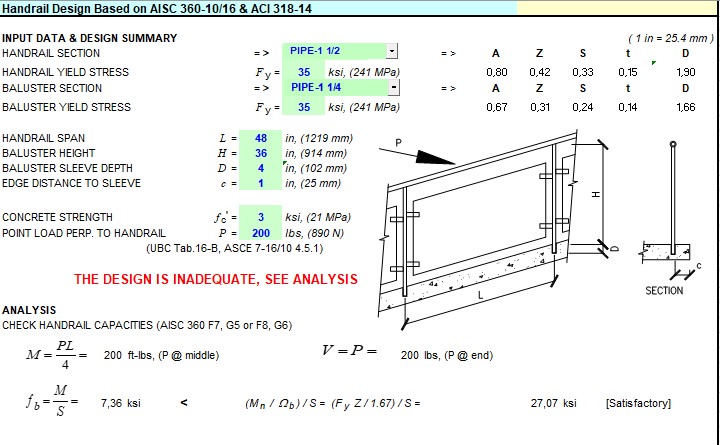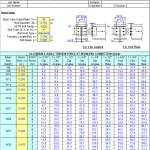
Handrail Design With Concentrated Load Based on ACI and AISC Spreadsheet
10 December 2022Handrail Design With Concentrated Load Based on ACI and AISC Spreadsheet
Handrails play a critical role in construction projects, ensuring safety, enhancing design aesthetics, and meeting regulatory compliance. Whether used in residential, commercial, or industrial spaces, handrails provide stability, guide movement, and prevent accidents. This article explores the key aspects of handrails in construction, highlighting their significance and the best practices for their implementation.
1. Ensuring Safety and Accessibility
Safety is the primary purpose of handrails. They offer support for individuals ascending or descending stairs, walking along ramps, or navigating elevated areas. Handrails are particularly vital for:
- Preventing Falls: In areas like staircases and balconies, handrails act as a protective barrier against accidental falls.
- Supporting Vulnerable Groups: Elderly individuals, children, and people with disabilities benefit from handrails as they provide stability and ease of movement.
- Emergency Situations: Handrails can serve as a guide during emergencies, helping people evacuate safely.
2. Meeting Regulatory Standards
Handrails in construction are subject to strict building codes and standards to ensure public safety. Common guidelines include:
- Height Requirements: Handrails must be installed at a height comfortable for users, typically between 34 and 38 inches (86 to 96 cm).
- Load-Bearing Capacity: They must be robust enough to withstand significant force.
- Continuity: Handrails should run continuously along staircases or ramps without interruptions to ensure usability.
- Grip Design: The shape and size should allow for a secure grip, reducing the risk of slips.
Compliance with standards like the International Building Code (IBC) and the Americans with Disabilities Act (ADA) is essential for avoiding legal penalties and ensuring inclusivity.
3. Enhancing Aesthetic Appeal
Beyond functionality, handrails contribute to the visual appeal of a space. Modern construction projects integrate innovative handrail designs that complement architectural themes. Popular materials and styles include:
- Stainless Steel: Durable and sleek, stainless steel handrails are common in contemporary designs.
- Wood: A classic choice for residential spaces, offering warmth and elegance.
- Glass: Paired with metal, glass handrails create a minimalist and sophisticated look.
- Cable Railings: Ideal for outdoor spaces, providing unobstructed views while ensuring safety.
4. Selecting the Right Material
Choosing the appropriate material for handrails depends on factors such as location, usage, and budget. Considerations include:
- Durability: Materials like stainless steel and aluminum resist corrosion and are ideal for outdoor or high-traffic areas.
- Maintenance: Wood requires regular upkeep, while metals and composites are generally low-maintenance.
- Cost: Balance between initial investment and long-term value to select a material that meets both aesthetic and functional needs.
5. Installation Best Practices
Proper installation is crucial for the effectiveness and longevity of handrails. Key steps include:
- Accurate Measurements: Ensure precise alignment with stairs or ramps for seamless integration.
- Secure Anchoring: Use high-quality fixtures to anchor handrails firmly to walls or floors.
- Professional Expertise: Employ qualified contractors to meet safety standards and achieve a polished finish.
6. Sustainable Handrail Options
With the growing emphasis on sustainability in construction, eco-friendly handrail options are gaining traction. Recycled metals, sustainably sourced wood, and energy-efficient manufacturing processes contribute to reducing the environmental impact.
Conclusion
Handrails are indispensable in construction, balancing safety, compliance, and design. By understanding their importance and following best practices, builders can create spaces that are not only functional but also visually appealing and inclusive. Whether you’re planning a new construction project or renovating an existing structure, investing in high-quality handrails is a step towards a safer and more accessible environment.








